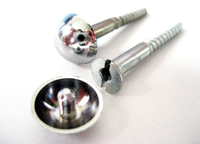








A screw, or bolt, is a type of fastener characterized by a helical ridge, known as a male thread (external thread) or just thread, wrapped around a cylinder. Some screw threads are designed to mate with a complementary thread, known as a female thread (internal thread), often in the form of a nut or an object that has the internal thread formed into it. Other screw threads are designed to cut a helical groove in a softer material as the screw is inserted. The most common uses of screws are to hold objects together and to position objects.
A screw will almost always have a head on one end which contains a specially formed shape that allows it to be turned, or driven, with a tool. Common tools for driving screws include screwdrivers and wrenches. The head is usually larger than the body of the screw, which keeps the screw from being driven deeper than the length of the screw and to provide a bearing surface. There are exceptions; for instance, carriage bolts have a domed head that is not designed to be driven; set screws often have a head smaller than the outer diameter of the screw; J-bolts have a J-shaped head which is not designed to be driven, but rather is usually sunk into concrete allowing it to be used as an anchor bolt. The cylindrical portion of the screw from the underside of the head to the tip is known as the shank; it may be fully threaded or partially threaded.The distance between each thread is called the "pitch".
The majority of screws are tightened by clockwise rotation, which is termed a right-hand thread; a common mnemonic device for remembering this when working with screws or bolts is "righty-tighty, lefty-loosey." Screws with left-hand threads are used in exceptional cases. For example, when the screw will be subject to counterclockwise torque (which would work to undo a right-hand thread), a left-hand-threaded screw would be an appropriate choice. The left side pedal of a bicycle has a left-hand thread.
More generally, screw may mean any helical device, such as a clamp, a micrometer, a ship's propeller or an Archimedes' screw water pump.
Accuracy and standardisation
Whitworth popularised a method of producing accurate flat surfaces during the 1830s, using engineer's blue and scraping techniques on three trial surfaces. Up until his introduction of the scraping technique, the same three plate method was employed using polishing techniques, giving less accurate results. This led to an explosion of development of precision instruments using these flat surface generation techniques as a basis for further construction of precise shapes.
His next innovation, in 1840, was a measuring technique called "end measurements" that used a precision flat plane and measuring screw, both of his own invention. The system, with a precision of one millionth of an inch, was demonstrated at the Great Exhibition of 1851.
In 1841 Whitworth devised a standard for screw threads with a fixed thread angle of 55° and having a standard pitch for a given diameter. This soon became the first nationally standardised system; its adoption by the railway companies, who until then had all used different screw threads, leading to its widespread acceptance. It later became a British Standard, "British Standard Whitworth", abbreviated to BSW and governed by BS 84:1956.